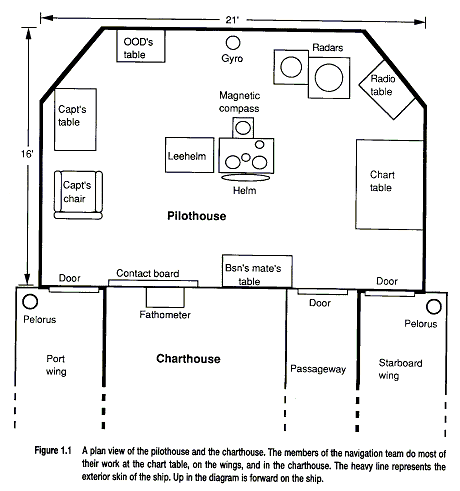Career Trajectory Through Different Roles
Vignette 1: Naval Navigation (Hutchins, 1995)
Cooperative Arrangement
Small team group of naval navigation workers (up to 10). Location in 4 spatially connected areas on the ships bridge: primarily the charthouse but also the pilothouse and pelorus (siting instrument) positions on the port and starboard sides of the ship. Description of the achievement of successive 'fix-cycles' (operation which details the ship's current position facilitating course planning). Focus on the career trajectory of workers whereby navigation staff progress through increasingly more difficult and more responsible roles. This builds in the ability for staff to supervise, advise staff below present standing demonstrate and complete tasks associated with these roles.
Representation of Activity
The work associated with different roles is represented on various devices and artefacts. There is no explicit recording of who carried out which task other than the readings, bearings and so forth are accountable to role. In cases where there is fluidity of role the record is with the staff themselves. Some of the activity is recorded transiently as the noted depths on gauges, bearings on the pelorus and so forth which are substituted with each new reading. The work and the reading is geared towards producing a permanent record on the chart in terms of the ships 'current' position. The role with most responsibility - the Quarter Master of the Watch (QMOW) - marks the current position.
Ecological Arrangement

The plan of the navigation areas is shown above (from Hutchins, 1995). The close proximity of the different areas in which navigation crew carry out their duties allows for the more senior staff, e.g. the QMOW to oversee, assist and take over the work of other crewmen.
Coordination Techniques
The activity has as its basis a standard procedural linearity. For example, the pelorus bearings are usually taken first, before other details (potentially depths, radar, celestial readings) before the position is fixed ands marked on the chart. Depending on contextual matters - e.g. who is on the 'watch' crew, where the ship is in relation to land, what the weather is like etc. - there may be fluidity of roles, as to who carries out which task, when and so forth. Coordination is achieved through audio channels to different areas and through face-to-face interaction, overseeing/hearing and so forth. Workers with more responsibility (e.g. QMOWs) have the ability supervise and monitor the tasks of those with roles below their present position due to their knowledge of these activities and to fluidly carry out these activities as situations demand.
Community of Use
Intra-organisational group of naval navigation staff on the bridge of a naval carrier focusing on the facilitation of work achievement and dependability afforded by career path.